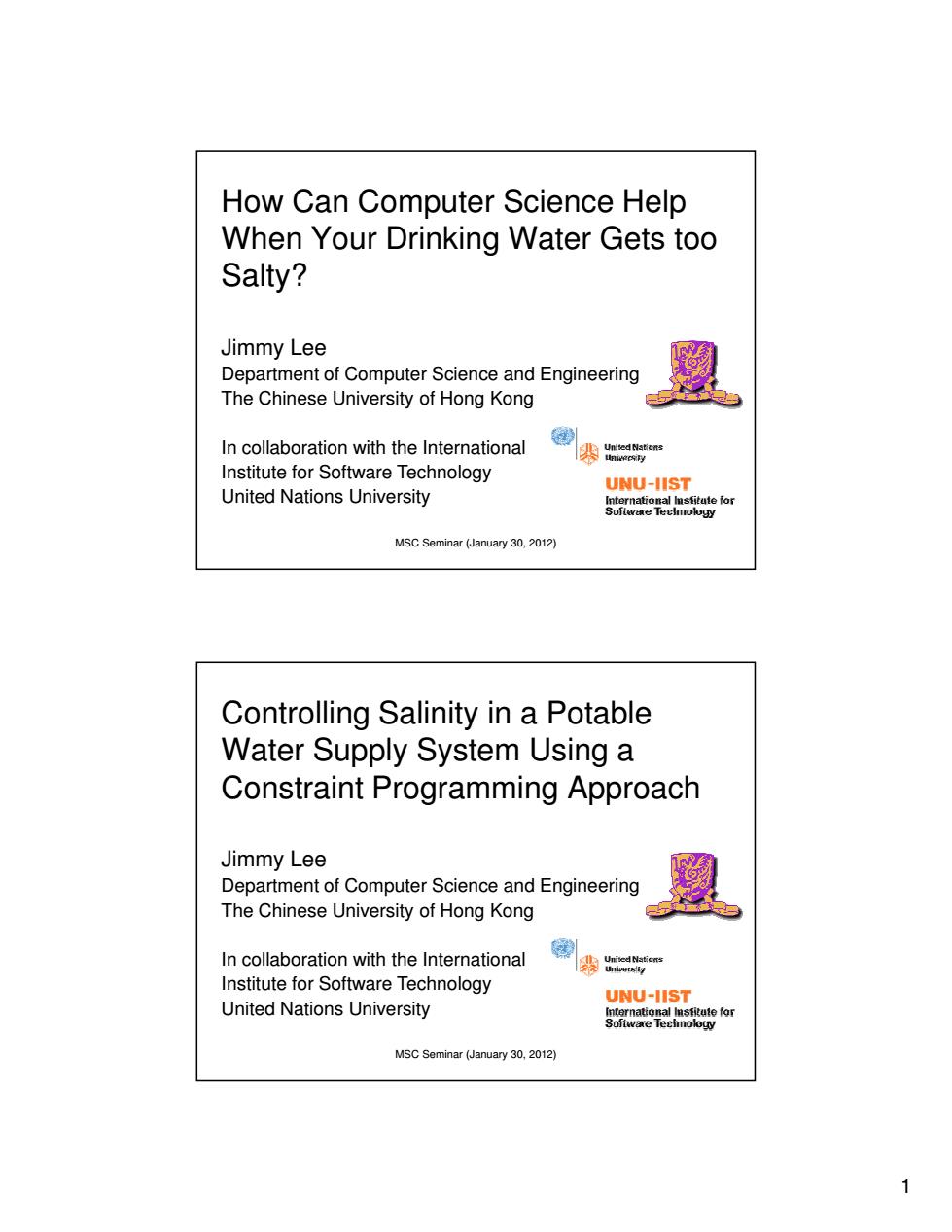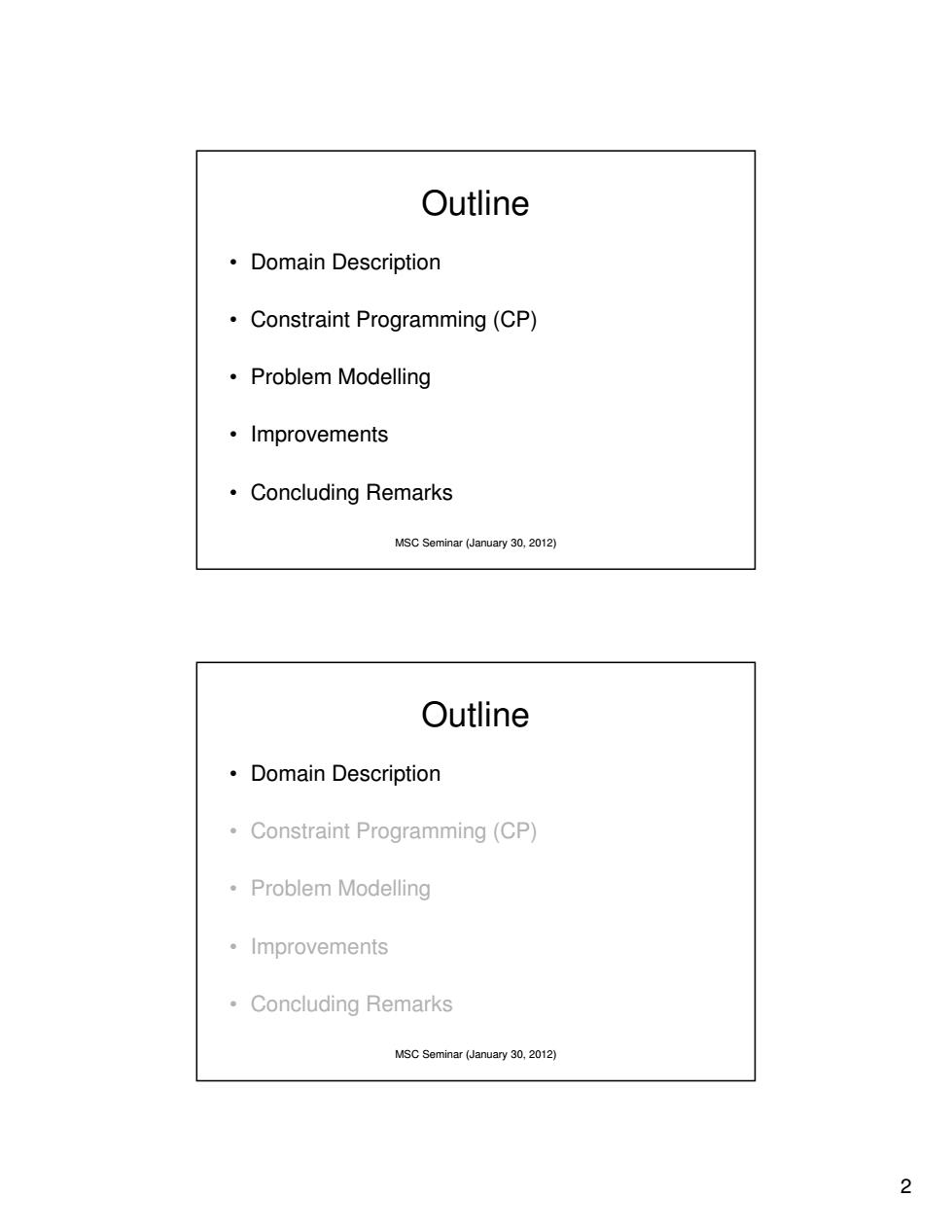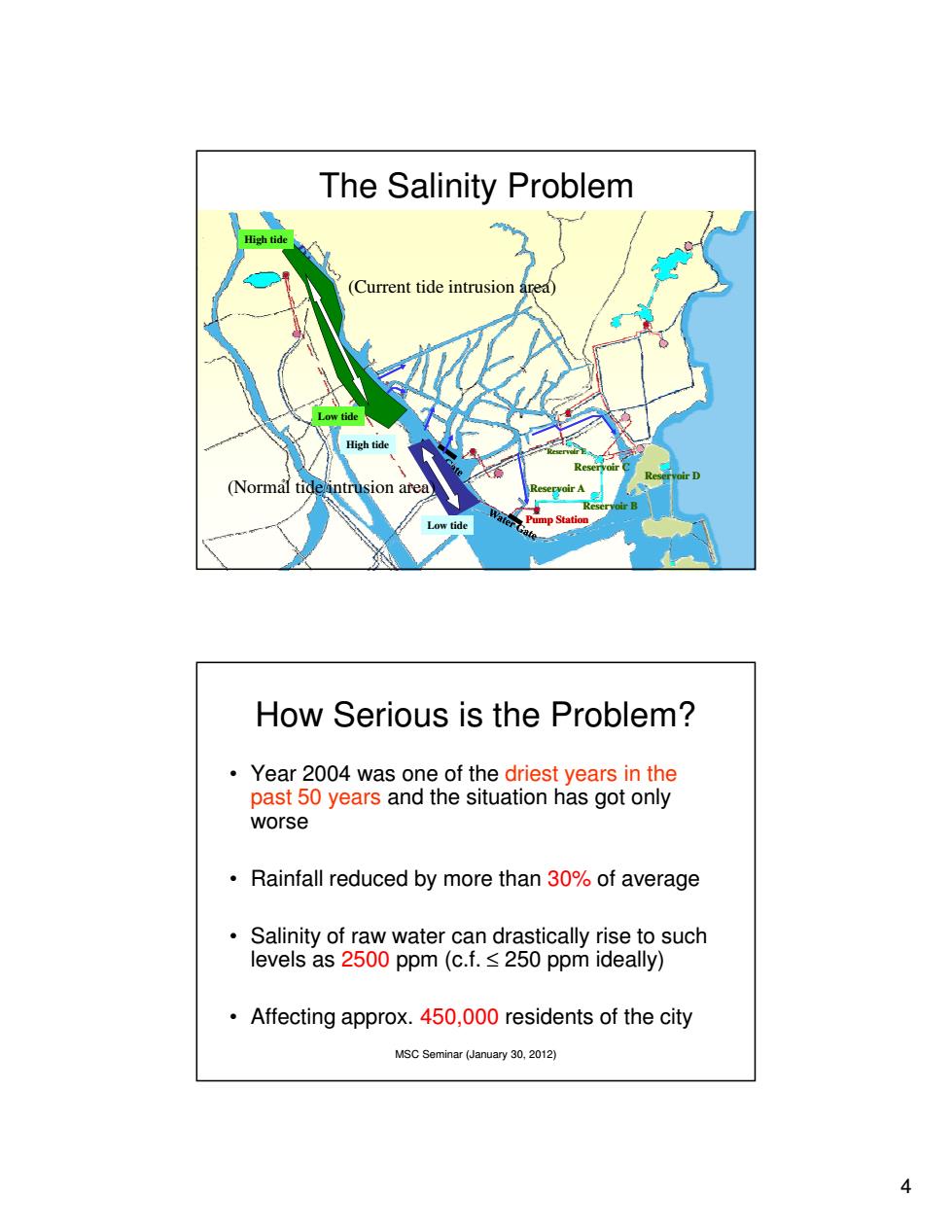
How Can Computer Science Help When Your Drinking Water Gets too Salty? Jimmy Lee Department of Computer Science and Engineering The Chinese University of Hong Kong In collaboration with the International 尖am univecsily Institute for Software Technology UNU-IIST United Nations University International Institute for Sofiware Technology MSC Seminar(January 30,2012) Controlling Salinity in a Potable Water Supply System Using a Constraint Programming Approach Jimmy Lee Department of Computer Science and Engineering The Chinese University of Hong Kong In collaboration with the International Institute for Software Technology UNU-IIST United Nations University International Istitute for Sofiware Teclmology MSC Seminar (January 30,2012) 1
1 MSC Seminar (January 30, 2012) How Can Computer Science Help When Your Drinking Water Gets too Salty? Jimmy Lee Department of Computer Science and Engineering The Chinese University of Hong Kong In collaboration with the International Institute for Software Technology United Nations University MSC Seminar (January 30, 2012) Controlling Salinity in a Potable Water Supply System Using a Constraint Programming Approach Jimmy Lee Department of Computer Science and Engineering The Chinese University of Hong Kong In collaboration with the International Institute for Software Technology United Nations University

Outline ·Domain Description Constraint Programming(CP) ·Problem Modelling ·Improvements ·Concluding Remarks MSC Seminar (January 30,2012) Outline ·Domain Description Constraint Programming(CP) 。Problem Modelling 。Improvements 。Concluding Remarks MSC Seminar (January 30,2012) 2
2 MSC Seminar (January 30, 2012) Outline • Domain Description • Constraint Programming (CP) • Problem Modelling • Improvements • Concluding Remarks MSC Seminar (January 30, 2012) Outline • Domain Description • Constraint Programming (CP) • Problem Modelling • Improvements • Concluding Remarks

Increasing Salinity in Water Salinity is the concentration SOCIO-ECONOMIC of salts in water RIVER INFLOW Decrease of river flow during dry seasons WIND WATER QUALITY Intrusion of sea water TIDE Duration depends on unforeseen factors such as tidal flow and weather conditions MSC Seminar(January 30,2012) The Raw Water System 3
3 MSC Seminar (January 30, 2012) Increasing Salinity in Water • Salinity is the concentration of salts in water • Decrease of river flow during dry seasons • Intrusion of sea water • Duration depends on unforeseen factors such as tidal flow and weather conditions TIDE RIVER INFLOW CURRENT WIND WATER QUALITY SOCIO-ECONOMIC MSC Seminar (January 30, 2012) The Raw Water System Pump Station Reservoir C Reservoir E Reservoir B Reservoir A Reservoir D

The Salinity Problem High tide (Current tide intrusion ared) Low tide High tide (Normal tide intrusion area) Low tide ump Station How Serious is the Problem? Year 2004 was one of the driest years in the past 50 years and the situation has got only worse Rainfall reduced by more than 30%of average Salinity of raw water can drastically rise to such levels as 2500 ppm(c.f.250 ppm ideally) Affecting approx.450,000 residents of the city MSC Seminar(January 30,2012) 4
4 MSC Seminar (January 30, 2012) Pump Station Reservoir C Reservoir E Reservoir B Reservoir A Reservoir D High tide Low tide (Normal tide intrusion area) Low tide High tide (Current tide intrusion area) The Salinity Problem MSC Seminar (January 30, 2012) How Serious is the Problem? • Year 2004 was one of the driest years in the past 50 years and the situation has got only worse • Rainfall reduced by more than 30% of average • Salinity of raw water can drastically rise to such levels as 2500 ppm (c.f. ≤ 250 ppm ideally) • Affecting approx. 450,000 residents of the city

Consequence of Salinity The salinity is more a matter of taste (increased content of chloride)than health while it is less than 2000 ppm Salinity level Taste 200-300ppm Very slight saline taste >300-600ppm Noticeable discomfort in taste >600-800ppm Increasing discomfort in taste >800-1000ppm Very strong discomfort in taste >1000-2000ppm Extremely strong discomfort in taste MSC Seminar (January 30,2012) W.H.O.Guidelines Average dietary intake of chloride for human -Ranging from 6 g/day to 12 g/day The consequence is that daily intake of salt from water is usually less than 5%to 10%of total intake from foods No evidence on health effect of prolonged intake of large amounts of chloride in diet -Except in the special case of impaired sodium chloride metabolism,e.g.in congestive heart failure MSC Seminar (January 30,2012) 5
5 MSC Seminar (January 30, 2012) Consequence of Salinity • The salinity is more a matter of taste (increased content of chloride) than health while it is less than 2000 ppm Salinity level Taste 200 - 300 ppm Very slight saline taste >300 - 600 ppm Noticeable discomfort in taste >600 - 800 ppm Increasing discomfort in taste >800 - 1000 ppm Very strong discomfort in taste >1000 - 2000 ppm Extremely strong discomfort in taste MSC Seminar (January 30, 2012) W.H.O. Guidelines • Average dietary intake of chloride for human – Ranging from 6 g/day to 12 g/day • The consequence is that daily intake of salt from water is usually less than 5% to 10% of total intake from foods • No evidence on health effect of prolonged intake of large amounts of chloride in diet – Except in the special case of impaired sodium chloride metabolism, e.g. in congestive heart failure